

http://jszostak.webs.com/View%20The%20Evidence.html
Because of space restrictions I was unable to include all of the anomalous photographic evidence within my books. As a result I have created this page that is dedicated to providing additional photographs and images in support of the explosive evidence presented in Evidence of Lost Ancient Civilizations: Case Closed (EOLAC:CC), Riddles of the Past: Solving Mankind's Ancient Mysteries (ROTP:SMAM), and Mankind's Origins: The Hidden Secret Revealed (MO:THSR). Accompanying each photo/image I reference its specific location inside my books along with some background detail.
Much of this evidence calls into serious question the evolutionary timeline that mainstream science and history have maintained. It clearly demonstrates that something very strange, mysterious and epic occurred on our planet in the distant past. How could dinosaurs and humans have co-existed when they supposedly lived 60 million years apart? What is the explanation for modern artifacts such as a metallic bell, doll, metallic chain, metal cup, golden wire, human teeth, fabric, hooks, obsidian earplugs, rings, nails, pipes and bowls found in coal, soil, and rock formations hundreds of thousands (or even millions) of years old? Who was responsible for the development of impossible ancient technology and mapping techniques that were never duplicated again until the 19th century - some 2,000 years later? What is the explanation for giant red-haired skeletons and strange-shaped skulls found around the world? Where does our historical record document this race of beings as having existed?
Keep in mind that the following exhibits comprise only a small fraction of the prevailing evidence which is available. Many more similar discoveries are detailed throughout my books. Most of the discoveries shown here were either made by archaeologists, anthropologists, geologists, botanists or other professional individuals or were subject to scrutiny, study and peer review by scientific sources to prove their validity.
Another addition to this page is a presentation of anomalous evidence from Mars and elsewhere within our Solar System. There is mounting proof that humanoid life on Earth could actually have originated on Mars, or somewhere else in our Solar System. The presence of so many artificial structures, and their similarity in style and design to ancient civilization buildings and architecture on Earth cannot lead to any other conclusion. Just the discussion of artificial structures existing on other planets and moons within our Solar System is amazing enough in itself. It should be heralded as the greatest discovery of all time, instead of being swept under the carpet as it has been for decades. Through this compelling evidence we now learn that mankind could have its ancestral roots on a neighboring planet right in our own backyard.
Our ancient history, or earliest beginnings here on Earth, could be traced to a mass migration from within our own Solar System. This would help to explain the many gaps and inconsistencies in the human evolutionary timeline. These two links are located at the bottom of the title search margin on the left side of this page and are labeled Mars Anomalies and Solar System Anomalies.
These are just some of the many mysteries that remain unanswered to this day that are explored in my books.
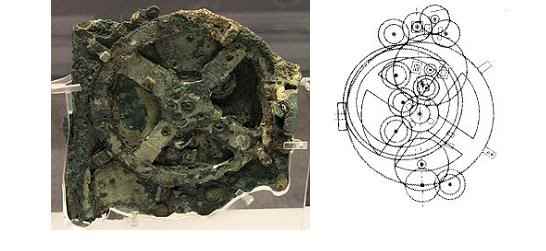
The Antikythera Mechanism is an ancient mechanical calculator (also described as the first mechanical computer) designed to calculate astronomical positions and alignments. It was discovered in a sunken wreck off the coast of Greece in 1900. It is estimated to have been constructed between 150-100 B.C. The device is remarkable for the level of miniaturization and complexity of its parts, which is comparable to 18th century clocks. It contains as many as 70 gears with teeth formed through equilateral triangles. Who would have had such an advanced knowledge of astronomy and mechanics to be able to construct such a device in 150 B.C., never to be duplicated for nearly 2,000 years? (EOLAC:CC Pg. 390)
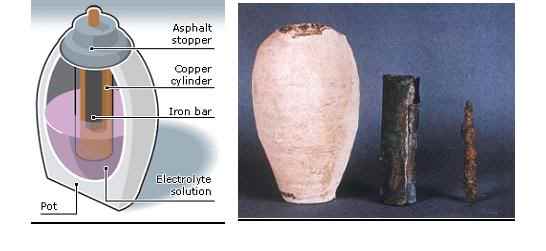
The Baghdad Electric Batteries are a number of artifacts created in 250-225 A.D. in Mesopotamia. These jars were discovered in 1936 near present day Baghdad, Iraq. Experiments with models of Baghdad electric batteries have generated between 1.5 and 2 volts. They consist of 5-1/2-inch high by 3-inch wide terracotta jars containing a copper cylinder made of a rolled-up copper sheet, housing a single iron rod. Their purpose is still unknown to this day. Some have suggested they may have been used for electroplating objects with gold. Others believe the batteries may have been used medicinally. Electricity was not invented until the 18th century. So where do the Baghdad electric batteries, built thousands of years earlier, fit in? And why isn't this included in our mainstream educational curriculum? (EOLAC:CC Pg. 391)
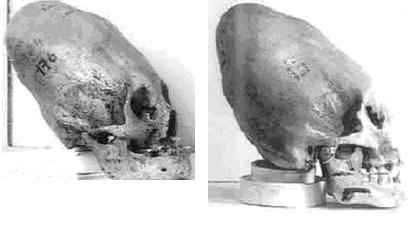
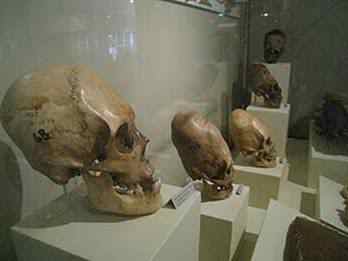
Thousands of cone-shaped skulls have been discovered the world over. Mainstream science is quick to explain these anomalies as being the result of a procedure known as "cranial binding", in which a person's head is tightly bound (usually from infancy) with cloth or leather straps throughout its lifetime, causing the skull to grow in this peculiar way. However, in most of the specimens there are no signs of forced compression leading to deformations normally caused by binding of the skull. If binding caused the deformities of the skull, there would have been deformities evident in the frontal region of the skull, which was not visible. Furthermore, binding of this kind would have also left a soft spot at the crown of the head, which was not apparent. Even assuming that these skulls were the result of cranial binding, what would have been the reason for doing this? Was it performed as a form of respect and tribute to their "gods" (extraterrestrial visitors) - something similar to "cargo cult" worship here on Earh? This could be one logical explanation considering this phenomena was global in nature and none of the cultures were aware of each other. Other anomalous features of the these elongated skulls include radiological studies indicating that brains contained within some of them were much larger than normal humans; others had six toes. (EOLAC:CC Pg. 247)

What happens when a very young child's complete skeleton is found intact with an already-formed and perfect elongated skull? What can the explanation be for this strange anatomical feature? The cranial binding theory can be dismissed since the child didn't live long enough for the process to have an effect. So how did this child develop an elongated skull so early in life? This is one example that modern science chooses to avoid like the plague - because it has no answer. Conventional science would no doubt claim this condition to be a mutation of some kind - an isolated, rare case involving some disease. But mutation cannot explain finding several elongated skulls in different regions of a country, or throughout the world. As disturbing as it may be to look at the photo on the left and consider its implications, it leaves us with only two possible explanations - (1) that some other type of humanoid lived on Earth very recently, along with Homo sapiens or, (2) that bio-genetic engineering was taking place on Earth sometime in the distant past. Either way it proves that something mysterious and epic happened on Earth long ago. (EOLAC:CC Pg. 247)
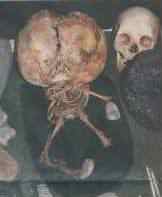
This anomalous skull was discovered in Iberia, Brazil. The mummified remains are housed in the Wilson Estanovic Museum of Natural History in Uberaba, Brazil. The skull is that of an infant, yet it is twice the size of a normal adult human skull. As the photo illustrates the size of the head is completely out of proportion in relation to the rest of the small body, which measures only 20 inches in length. Another interesting feature is that it has six toes. Polydactily (having an extra toe or finger) is not so unusual in itself, but if this child is alien-human hybrid then we have to at least consider the theory that polydactily could be a genetic throwback to DNA manipulation that occurred in Earth's ancient past. (EOLAC:CC Pg. 249)
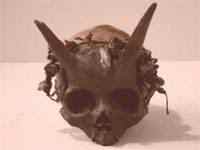
The existence of what appears to be numerous horned skulls is probably one of the most controversial artifacts in existence, and certainly not one that modern science can easily explain away. The skull shown here was discovered in France. Analysis and X-ray examination of the skull demonstrated that the horns were genuinely part of the skull and that it was not a forgery. It is only one of hundreds found worldwide and currently sits on display at the London Museum. Several 7-foot tall skeletons with horned protrusions were unearthed in Bradford County, Pennsylvania. (EOLAC:CC Pg. 256)
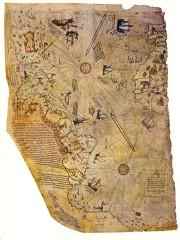
The map pictured here is the famous Piri Reis Map from 1513 created by the Turkish admiral and cartographer of the same name. It is the oldest surviving map to show the Americas. The map is particularly noteworthy for its depiction of a southern landmass that appears to be Antarctica, which wasn't known to the world until its discovery in 1820. Even more amazing are a series of notes on the map explaining that it was compiled and copied using data from a number of earlier source maps, which dated back to the 4th century B.C. or earlier. Other claims of this map and several others like it include: (a) they show the Earth as seen from outer space orbit; (b) they show the sub glacial topography of Greenland; (c) they show the sub glacial topography of Antarctica. How did our ancient ancestors acquire such detailed knowledge of the Earth, only attainable from an aerial reconnaissance. (EOLAC:CC Pg. 401)
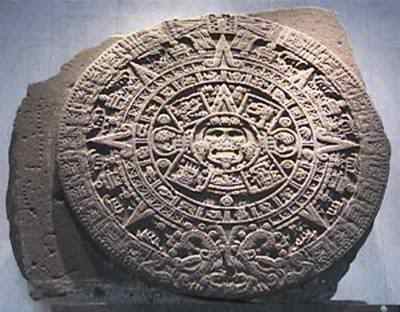
The Mayan calendar (photo on left) was of a highly complex design, advanced and accurate to several decimal places. Yet this incredible work of calculation was achieved well over a thousand years ago. In addition, Mayan knowledge of astronomy, particularly the cycles of the planets and the sidereal year were all expressed to an uncanny degree of accuracy. This work couldn't have been better accomplished with precision measuring devices like those of today. The Mayan calendar is truly an astonishing achievement. It terminates on December 21, 2012 and many have speculated that this signifies the end of the world. However, what is most interesting is the fantastic extent of the time periods that the calendar encompasses. This Long Count of Days, as it is known, consists of the aggregate total of five different time cycles. It means the cumulative total makes possible the accurate dating of events unimaginably distant. The highest unit in this calendar, the alautun, is equivalent to 63 million years. One Mayan inscription from Quirigua mentions events occurring 90 million years ago. Another inscription from the same locality goes back even further to 400 million years. But why use such incredible numbers? What purpose was there for them? For although we ourselves use dates equally as long, they are usually in reference to rather vague geological time periods whose boundaries are difficult to define within a couple of million years. Yet the Mayan records display none of this vagueness. They mention specific dates that are millions of years old. Incredibly, the Mayan calendar provided the ability to refer to events on particular days, weeks, and months many millions of years ago. (ROTP:SMAM Pg. 176)


The origin, language, and date of the Voynich Manuscript (two photos on left) are still being debated as vigorously as its puzzling drawings and undeciphered text. Described as a magical or scientific text, nearly every page contains botanical and scientific drawings in ink with vibrant washes in various shades of green, brown, yellow, blue, and red. The Voynich Manuscript is considered to be "The Most Mysterious Manuscript in the World". To this day this medieval artifact resists all efforts at translation. The manuscript is named after its discoverer, the American antique book dealer and collector, Wilfrid M. Voynich, who discovered it in 1912 amongst a collection of ancient manuscripts kept in villa Mondragone in Frascati, near Rome. Based on the evidence of the calligraphy, the drawings, the vellum, and the pigments, Wilfrid Voynich estimated that the manuscript was created in the late 13th century. The manuscript is small - seven by ten inches, but nearly 235 pages thick. It is written in an unknown script of which there is no known other example in the world, and is abundantly illustrated. No one really knows the origins of the manuscript. The experts believe it is European and was written between the 15th and 16th centuries. It is an alphabetic script, but of an alphabet believed to have from 19 to 28 letters, none of which bear any relationship to any English or European letter system. The text has no apparent corrections. There is evidence for two different languages and more than one scribe, probably indicating an ambiguous coding system. Apparently Voynich wanted to have the mysterious manuscript deciphered and provided photographic copies to a number of experts. However, despite the efforts of many well known cryptologists and scholars, the book remains unread. There are some claims of decipherment, but to date, none of these can be substantiated with a complete translation.
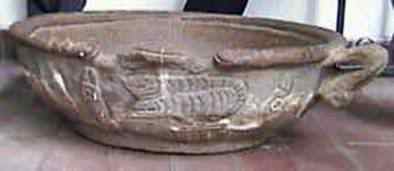
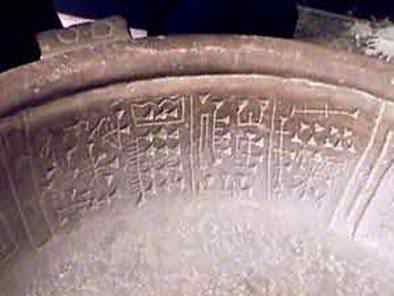
A large stone vessel, resembling a libation bowl, and now known as the Fuente Magna (two photos on left), was originally discovered by a country peasant in the Lake Titicaca area, about 50 miles from La Paz, Bolivia. The site where it was found has not been subject to investigation until recently. The Fuente Magna was not shown publicly in Bolivia until the year 2000. Up until then it was considered false, until investigations began. It is beautifully engraved in chestnut-brown both inside and out. Study has continued into what many refer to as the "Rosetta Stone of the Americas". Preliminary investigations indicate that: we are dealing with an artifact which was made in keeping with Mesopotamian tradition; it contains two texts, one in cuneiform and another Semitic language; according to the symbols used this artifact appears to date from the transitional period between ideographical writing and cuneiform; chronologically this leads us to the 3500/3000 B.C. (Sumerian/Akkadian) period.

Photo on left shows a human footprint within a trail of dinosaur tracks in a Texas river bed. Photo on right is a human sandal print taken from inside of a slab of rock dated to the Cambrian period, over 500 million-years-old. These are only a sample of hundreds collected worldwide. Dinosaurs were supposedly wiped out in a mass global extinction 65 million years ago. Bipedal humans have only walked the Earth for less than 3 million years, pre-human primates less than 7 million years. So how could human footprints be found alongside those of dinosaurs, or in 500 million-year-old rock formations? (EOLAC:CC Pgs. 421-423)
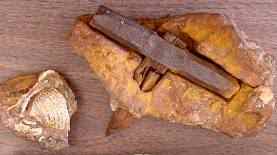
This iron and wooden hammer, also known as the London Artifact was found by local hikers in a creek bed near London, Texas. The hammer, which was partially embedded in a small limy, rock concretion, originated in a Cretaceous rock formation (100 million-years-old), thus contradicting the conventional geological timetable. (EOLAC:CC Pg. 429)
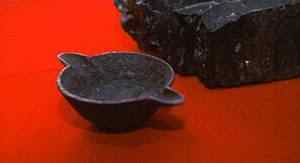
An electric company employee in Arkansas broke open a large lump of coal, revealing this man-made iron pot. The original coal bed was reportedly mid Pennsylvanian age - about 300 million-years-old by geological standards. (EOLAC:CC Pg. 429)
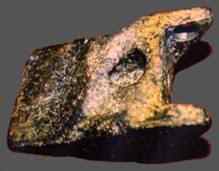
In Romania a group of workers, on the banks of the river Mures, discovered three buried objects in a trench 33 feet deep. Two of the objects were Mastodon bones, millions of years old from the Miocene and Pleistocene periods. The third object pictured here, resembling the head of a hammer, was sent for study to the archaeological institute of Cluj-Napoca. Examination of this object ignited a debate within the scientific community. The fact that this unusual metal object is found together with very ancient bones is very strange. (EOLAC:CC Pg. 336)

This mystery rock was found with an embedded man-made like electrical component pin. It was found encased in a very hard dirt and only the tips of the pins exposed, and required many hours to clean around the pins using a dental tool. The material is solid, natural quartz and feldspar granite, has very little observed mica and not an accretion, concretion, or pumice. It does not contain any resins, cements, glues, limestone, mortar, or other non-granite binding agents. It is very hard, and estimated to be at least 100,000 years-old. What is its origin? What was its purpose? (EOLAC:CC Pg. 337)
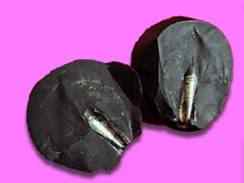
This strange stone was found on a field research trip to the Mazong Mountain area located on the border of Gansu and Xijiang provinces in China. The pear-shaped stone is extremely hard and has a mysterious black color. It is embedded with a 2.4-inch long cone-shaped metal bar having clear screw threads. The screw thread width remains consistent from the wide end to the narrow end, instead of varying width due to the growth of organisms. The screw thread metal bar is tightly enclosed inside the black lithical material. Neither the bar's entrance to the stone nor the exposed bar tip appear to be man-made. Many geologists and physicists from around the world have examined this mysterious stone and have not been able to determine its origin. (EOLAC:CC Pg. 338)
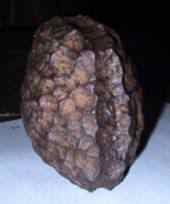
This object was removed from a block of brown coal that had been mined in Wolfsegg, Austria. It has since become known as the Salzburg Cube. The tertiary coal deposit in which it had been embedded is dated to about 60 million years ago. In 1886 one geologist suggested that its was meteoritic in origin. It was exhibited from 1950-58. In 1966-67 it was analyzed using electron-beam microanalysis. There were no traces of nickel, chromium, or cobalt in the iron suggesting that it was not of meteoritic origin. The lack of sulphur showed that it was not a pyrite. Many experts agree that because of the straightness, sharpness and uniformity of the edges it was a machine-made instrument and part of a much larger device. (EOLAC:CC Pg. 344)
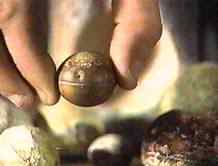
South African miners have found hundreds of these metallic spheres, which have three parallel grooves running around their equator. The spheres are 1-4 inches in diameter. The curator of the Klerksdorp Museum, where some of them are housed, insists that they are a complete mystery. They appear to be man-made, yet at the time in Earth's history when they came to rest in this rock no intelligent life existed. The spheres have been found in a Precambrian mineral deposit (a layer of pyrophyllite rock) said to be 2.8 billion-years-old! (EOLAC:CC Pg. 430)
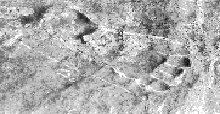
In a story from American Anthropologist, comes the finding of a perfect human imprint in stone near Parkersburg, on the West Virginia side of the Ohio River. The track is 14-1/2 inches long, and was embedded in stone dated at 150 million-years-old. (EOLAC:CC Pg. 433)
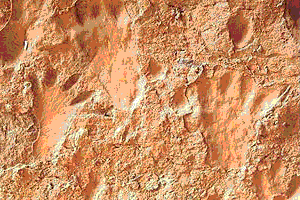
Brazil's Barra do Garcas region has a rich and mystical history. Local Indian legends tell of a time when there were small creatures, approximately four-feet in height, living among their ancestors. These beings all had a disproportionate head-to-body ratio and unlike humans walked with three, four and even six toes on each foot (photo on left). According to legend they lived in caves and came from the stars. (ROTP:SMAM Pg. 141)
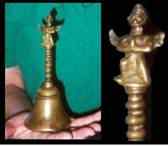
This metallic bell was found inside of a large piece of coal in West Virginia. The bituminous coal formation that was mined in this area is estimated to be 286-360 million-years-old. (EOLAC:CC Pg. 433)

This metallic vase was dynamited out of solid rock in Dorchester, Massachusetts. The vase metal was composed of a zinc alloy and contained a considerable portion of silver. The chasing, carving and inlaying are exquisitely done by the art of some unknown craftsman. The vase was blown out of solid pudding stone from 15 feet below the surface. The estimated age of the stone was 100,000 years. After more than 150 years of investigation the artifact remains unidentified. Originally presented at Harvard University, it has been passed along to the Museum of Fine Arts in Boston, who co-operated with M.I.T. in an attempt to determine its place and period of origin. (EOLAC:CC Pg. 432)
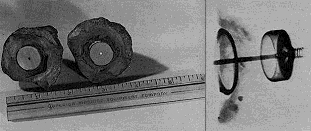
The Coso Artifact was discovered in the mountains of California near Olancha. It was believed to be a geode rock formation. After cutting it open a porcelain object was found inside. In the center was a shaft made of shiny material. Experts estimated that, if this was a geode, it should have taken about 500,000 years for this fossil-encrusted nodule to form, yet the object inside was obviously of sophisticated human manufacture. Further investigation has identified the artifact as a 1920s-era Champion spark plug. How could a 1920s spark plug get inside of a 500,000 year-old rock? (EOLAC:CC Pg. 433)
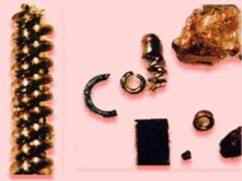
Between 1991-93 these objects were discovered in the Ural Mountain region of the Soviet Union. Their sizes range from 1.2 inches down to an incredible 1/10,000th of an inch. They were pulled from depths of up to 40 feet. Tests carried out give an age for the objects of between 20,000 and 318,000 years. The objects are composed of various rare metals such as tungsten and molybdenum. These objects are obviously the product of an inexplicable and highly advanced technology. What was their purpose? Which of our distant ancient ancestors were capable of producing such precision artifacts? (EOLAC:CC Pg. 340)
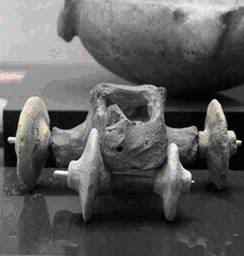
The world's oldest toy car (photo on left) was unearthed during excavations in the Kiziltepe district of the southeastern province of Mardin, and is currently on display at the Mardin Museum in Turkey. Turkish archaeologists claim the toy car, which is made from stone, dates back to the late Stone Age and is believed to be 7,500 years old. But where did they get the idea for a car? This artifact closely resembles an Egyptian chariot - used many thousands of years later. Could this be a copy of one of those chariots? The only problem is that this toy model was built 2,000 years before the invention of the wheel - a real quandary for mainstream archaeology to explain.
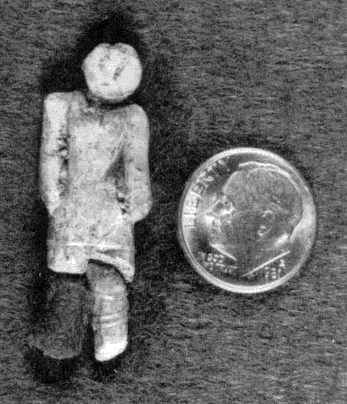
The Nampa Doll is a clay doll discovered in Nampa, Idaho. It measures 1-1/2 inches in length and was brought up by a well drill from a depth of 300 feet. The strata at this depth is dated at about 2 million years old. This figurine was found under several different strata including 15 feet of lava basalt. Also from this depth were brought up many small clay balls. The presence of iron on the surface of the figurine indicates that it is of ancient origin and could not have been hoaxed. Many scientists who investigated the incident shortly after the discovery agreed that the figurine is authentic. This anomalous artifact clearly does not fit within the established theory of human evolution and history. (EOLAC:CC Pg. 431)
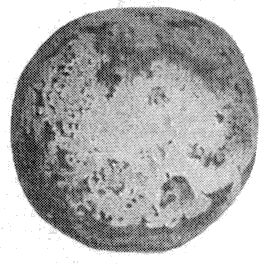
This chalk ball was discovered in an early Eocene lignite bed. Based on its stratigraphic position, it has been assigned a date of 45-55 million years ago. According to one professional source there was no possibility that the chalk ball was a forgery. It was penetrated over four-fifths of its height by a black bituminous color that merged toward the top into a yellow circle, and which was evidently due to the contact of the lignite in which it had been for so long a time plunged. As to the rock in which it was found, it was perfectly virgin and showed no trace whatsoever of any exploitation. Who built this man-made artifact so long ago in our distant past, 40 million years before humans were supposed to have existed? (ROTP:SMAM Pg. 145)
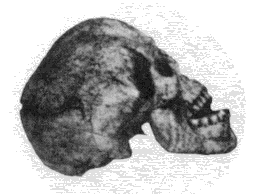
This modern skull, found in Tanzania, is from a fully human skeleton that remains a source of mystery to this day. The human skeletal remains, including this complete skull, were cemented into a rock and had to be chipped away with hammers and chisels. It was found in the upper end of a rock bed dated at more than 1 million-years-old. The skeleton was distorted by compression from the weight of substantial accumulation of sediment in the overlying strata, proving that it wasn't a shallow burial. How did this modern human find their way 1 million years into the past? (EOLAC:CC Pg. 258)
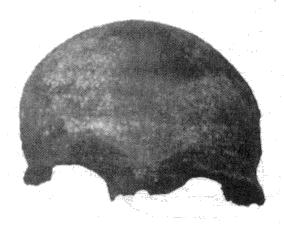
Workers excavating a dry dock in Buenos Aires, Argentina found this modern human skull. The stratum in which the skull was found was at least 1 to 1.5 million-years-old. Even at 1 million years the presence of a fully modern human skull anywhere in the world is highly anomalous. Why and how did a modern human arrive in Buenos Aires over 1 million years ahead of its time? (ROTP:SMAM Pg. 145)
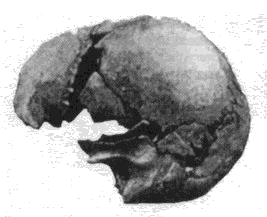
This anatomically modern human skull was found in Italy. The stratum from which it was taken is assigned to the Astian stage of the Pliocene, giving the skull an age of 3-4 million years. Why and how did this modern skull visit Italy nearly 2 million years before humans walked the planet? (ROTP:SMAM Pg. 145)
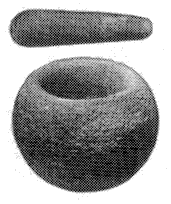
This pestle and mortar were found in a California tunnel. They were discovered at a distance of 1,400-1,500 feet from the mouth of the tunnel, or 200-300 feet beyond the edge of the solid lava. It was impossible for these relics to have reached the location which they were found excepting at the time the gravel was deposited, and before the lava cap formed. The position of these artifacts in gravel close to the bedrock indicates they were 33-55 million-years-old. Grazing and carnivorous mammals had not been evolved on Earth at this time. So who brought and left behind these artifacts nearly 50 million years ago? (EOLAC:CC Pg. 342)

This statue, know as the Venus of Willendorf, was discovered in Austria. It is a 4-3/8 inch tall statuette of a female figure dated at 30,000 years old, carved from an oolitic limestone that is not local to the area, and tinted with red ochre. Who could have created and left behind this artifact nearly 20,000 years before human civilization appeared? (ROTP:SMAM Pg. 145)
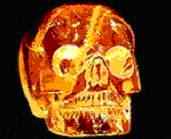
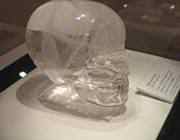
Crystal skulls are human skull models made from clear or milky quartz crystal rock believed to be pre-Columbian Mesoamerican artifacts. They have been found in various locations throughout the world. Thirteen of them have been found in parts of Mexico, Central America and South America. Microscopic examination shows no sign of tool marks. Modern science is stumped in explaining how a primitive culture could have carved crystal into such precise shapes and against the natural axis of the crystal. Even with today's elaborate laser equipment, it would be extremely difficult to create such crystal sculptures. (EOLAC:CC Pg. 363)

Workers in the Costa Rican jungle stumbled upon more than 300 of these spherical stone balls. They range in size from as small as a tennis ball to an astonishing 8-feet in diameter, weighing 16 tons. They are believed to have been carved between 200 B.C. and 1500 A.D. Although these stone balls are clearly man-made it is unknown who made them, for what purpose and, most puzzling, how those responsible for building them were able to achieve such spherical precision. (EOLAC:CC Pg. 360)

What appears to be a fossil of a human handprint and finger were found in limestone estimated to be 110 million-years-old in the Canadian arctic. (EOLAC:CC Pg. 435)
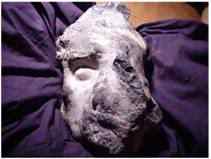
This photo is a fossilized head of a man discovered near Gothenburg, Sweden. It clearly appears to be the head of a man, with very recognizable features immortalized in stone, or in this case flint. This presents a huge problem for current evolutionary and geological theories since flint (or any rock for that matter) was supposedly formed tens of millions of years before humans evolved. According to current geological theories flint stones were developing during the Cretaceous period 65-140 million years ago. This evidence challenges the traditional views on human evolution. (ROTP:SMAM Pg. 141)
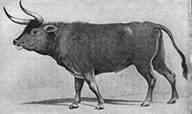
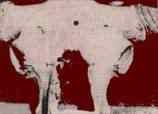
An Auroch is a large, buffalo-like animal that inhabited Europe, Asia and North Africa. It has been extinct for quite some time. Many skeletons have been found in Europe. What is remarkable about one located in the Moscow Museum of Paleontology is that it has a bullet hole in its skull (photo on right). The hole is round, without radial cracks that would result from slower projectiles like spears or arrows. It has been suggested that its skeleton may have been shot several times after its death. The only problem is that this auroch survived the wound and lived long enough for unmistakable calcification to appear at the site of the injury. (EOLAC:CC Pg. 362)
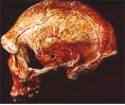
A similar round, clean, smooth hole without radial cracks was found in the skull of a Neanderthal man discovered in Rhodesia. The man supposedly died over 40,000 years ago. The skull is currently at the British Museum. It was found more than 50 feet below ground level. In addition to the hole consistent with that made by a bullet, the other side of the skull was blown out from the inside. One German forensic scientist who examined the skull stated categorically that the wound could only have come from a bullet because of the velocity necessary to produce the characteristics of the wound. (EOLAC:CC Pgs. 362-363)
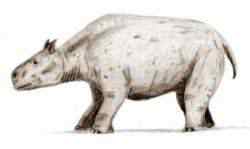
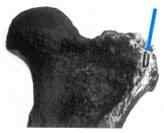
The Toxodon was supposedly extinct nearly 2 million years ago, a time when hunter-gatherer humans did not exist. It was a large herbivore about 9 feet long and 5 feet high resembling a modern rhinoceros. It is speculated that these animals lived in South America and were hunted by the saber-toothed tiger. This toxodon has an arrow or spear point in the bone (blue arrow in photo on right). (EOLAC:CC Pg. 363)
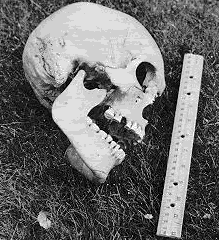
Miners working in a cave 22 miles southwest of Lovelock, Nevada stumbled upon the mummified remains of an individual that must have stood between 6-1/2 feet and 8 feet in height. Photo on left shows skull next to a yardstick for comparison. It couldn't have been a Native American because it had distinctively red hair. Ancient legends of the local Paiute Indians described a race of red-haired giants who were the enemies of many Indian tribes of the region. Between February and June of 1931 two large skeletons were found in the Humboldt lake bed near Lovelock. The first of these skeletons measure 8-1/2 feet tall, the second was almost 10 feet tall. In 1939 a 7-foot 7-inch skeleton was discovered on a ranch near Lovelock. (EOLAC:CC Pg. 262)
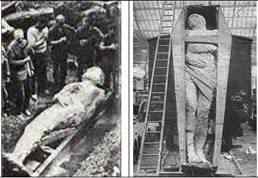
This fossilized giant was discovered during mining activities in County Antrim, Ireland. In the photo on the right it is compared standing upright to a goods wagon. The main measurements were as follows: total height 12 feet 2 inches, theoretic circumference 6 feet 6 inches, length of arms 4 feet 6 inches, weight 4,112 pounds. The right foot also had six toes. (ROTP:SMAM Pg. 148)
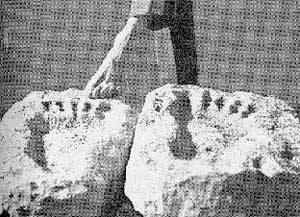
In South Africa a giant footprint of a woman measuring over 4-feet in length has been dated at approximately 9 million-years-old. Pointing to the probability of this being a female human-like species foot, proportionally the two-legged being would need to be some 30 feet tall. The local African people commonly refer to this as a highly revered and sacred site. (EOLAC:CC Pg. 268)

In 1961 Dr. Javier Cabrera received a gift of a strange stone from a local farmer. These andesite stones (photo on left) are estimated to be between 500 and 1,500 years old and have become known as the Ica Stones. The most astonishing feature of the stones is that the etchings clearly represent various dinosaurs - brontosaurus, triceratops, stegosaurus and pterosaurs. Cabrera has since collected over 15,000 of these stones. How would people living 1,500 years ago have any knowledge of dinosaurs, that were supposed to have been extinct 65 million years ago? (EOLAC:CC Pg. 416)
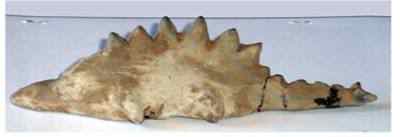

The terracotta statue and plate pictured here showing a strange dinosaur/sauropod with plates on its back were discovered in Italy near Caria. The area where these objects were found is estimated to be at least 3,000 years old. The plates are triangular and continue along the back until reaching the tail. The view from above the object reveals a strange curving of the plates, as if the animal had been represented in motion on the land. Some have suggested that this could be a salamander or lizard. However, neither of these two animals have plates on their back as depicted in these objects. How would people living 3,000 years ago have any knowledge of dinosaurs, that were supposed to have been extinct 65 million years ago? (EOLAC:CC Pg. 358)

The picture on the left is from a Mesopotamian cylinder seal dated from 3300 B.C. The animal on the right is an artist's conception of an Apatosaurus taken from a skeleton. There are many striking similarities between the two depictions. Where did the original artist, in 3300 B.C., get the model to draw such an accurate representation of a saurapod? (EOLAC:CC Pg. 384)
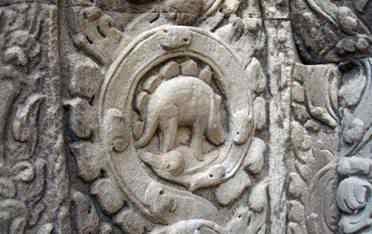
This photo is taken from the stunning Ta Prohm Temple located deep in the jungles of Cambodia. This temple is the work of the remarkable Khmer civilization which lasted from around 800 A.D. to 1400 A.D. Unlike most Angkorian temples Ta Prohm has been left in much the same condition in which it was found. The temple is covered with the most intricate of carvings, including very distinct and clear images that seem to depict a Stegosaurus. This would indicate that this creature might well have survived up until the Khmer era in the region. Local experts insist that it is unlikely that these images are a recent addition to the temple. According to conventional science this species existed in North America and died out around 155 million years ago. Villagers in the vicinity of the temple are said to retain traditions of this animal existing until fairly recent times. (ROTP:SMAM Pg. 35)
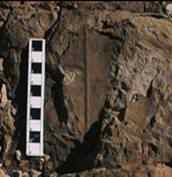
Discovery of fossilized stumps of deciduous trees in Antarctica indicates that it once enjoyed a much warmer climate in the past. Photo on left is of a fossilized leaf. The lack of frost rings in stump samples suggests that there were no hard frosts during their growing period. Remains of a 260 million-year-old forest of deciduous trees is located only 400 miles from the South Pole. In 1958 Charles Hapgood presented his revolutionary polar shift theory that both poles and the Earth's crust have shifted several times in the past. His main contention was that Antarctica was once situated at least 2,000 miles further north from its present position, in the middle of the Atlantic Ocean, between South America and Africa. This goes a long way in explaining how and where an ancient civilization (Atlantis) might have once thrived. (EOLAC:CC Pg. 394)


The Hindu Kailasa Temple (two photos on left) in India is one of the most stunning architectural achievements on Earth. Carved to represent Mt. Kailasa, the home of the god Shiva in the Himalayas, it is the largest monolithic structure in the world, carved top-down from a single rock. It contains the largest cantilevered rock ceiling in the world. The scale at which the work was undertaken is enormous. It covers twice the area of the Parthenon in Athens, is 1.5 times higher, and it entailed removing 200,000 tons of rock. It is believed to have taken 7,000 laborers 150 years to complete the project. The temple itself is 164 feet deep, 109 feet wide, and 98 feet high.

In Delhi, India is the famed Ashoka Iron Pillar (photo on left), generally believed to date from the 4th century A.D., but said by some scholars to be over 4,000 years old. It is a solid shaft of iron 16 inches in diameter, standing 23 feet high and weighing more than 6 tons. It has attracted the attention of both archaeologists and metallurgists, as it has withstood corrosion and decomposition for over 1,600 years in the open air. The pillar defies explanation, not only for not having rusted, but because it is apparently made of 98 percent pure wrought iron. This testament to the high level of skill achieved by ancient Indian ironsmiths can only be produced today in tiny quantities by electrolysis. The mystery of the use of iron in Asia, especially in India, is one that largely baffles modern metallurgists. Is is assumed that these countries developed iron and other metallurgical skills after the west, but the evidence indicates otherwise. The pillar bears an inscription which states that it was erected in honor of the Hindu god Vishnu, and in memory of the Gupta King Chandragupta II (375-413 A.D.). How the pillar moved to its present location remains a mystery. (EOLAC:CC Pg. 353)
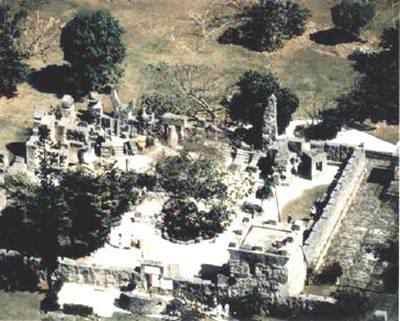



Not all megalithic sites on Earth are ancient. Ed Leedskalnin was an eccentric Latvian immigrant to the United States and amateur sculptor who single-handedly built the monument site known as Coral Castle in Florida (four photos on left). He was also known for his unusual theories on magnetism. At the age of 26, he was engaged to marry Agnes Scuffs, a girl ten years younger. However, the girl that Leedskalnin referred to as his "Sweet Sixteen" broke the engagement the night before their wedding. Several years later he immigrated to North America where he found work in lumber camps in Canada, California, and Texas. After contracting a case of tuberculosis Leedskalnin moved to the warmer climate of Florida around 1919, where he purchased a small piece of land. Over the next 20 years he constructed and lived within a massive coral monument he called Rock Gate Park, dedicated to the girl who had left him years before. Working alone at night, Leedskalnin quarried and sculpted over 1,100 tons of coral into a monument that would later be known as Coral Castle. Located in Homestead, Florida Coral Castle is one of the most amazing structures ever built. In terms of accomplishment it has been compared to Stonehenge, ancient Greek temples, and even the great pyramids of Egypt. It is truly amazing - some say miraculous - because it was quarried, fashioned, transported, and constructed by one man who was 5-feet tall and weighed only 100 pounds. The Nine-ton Gate on the property is a testament to Leedskalnin's genius (bottom photo on left). The gate, originally used as a turnstile, is perfectly mounted and balanced so that a child can open it with the touch of a finger - a remarkable achievement considering its size and weight. The gate is approximately 80 inches wide by 92 inches tall and is 21 inches thick, and fits within a quarter of an inch of the walls on both sides. The mystery of the Nine-ton Gate has been documented on numerous television shows and in a variety of print publications. In 1986 a team of engineers was brought in for consultation. In order to remove the gate, six men and a 50-ton crane were utilized. Leedskalnin often spoke of having learned the secrets of the pyramids, and having found out how the Egyptians and the ancient builders in Peru, Yucatan and Asia, with only primitive tools, raised and set in place blocks of stone weighing many tons. Leedskalnin gave polite, but cryptic answers to visitor's questions regarding his construction methods, which to this day remain a mystery. Did Ed Leedskalnin rediscover the secrets to the building of the pyramids, of levitation, of anti-gravity? His amazing Coral Castle may hold clues to long-lost powers. (EOLAC:CC Pg. 117)

The Georgia Guidestones (photo on left) monument is located In Elbert County, Georgia (USA). It is a 20-foot tall monument made of six astronomically aligned granite slabs. There is a capstone, one slab stands in the center, and around it stand four vertical slabs. The north/south pair of slabs is aligned to the poles. The central hollow of the structure is designed to be lit by light from the sun at noon no matter the time of year. The entire monument weighs 118 tons and is fitted with a small hole that will allow one to stand at the base and observe the North Star. An additional stone tablet, which is set in the ground a short distance to the west of the structure, provides some clarifying notes on the history and purpose of the Guidestones. A message consisting of a set of ten guidlelines or principles is engraved in eight different languages, one language on each face of the four large upright stones.
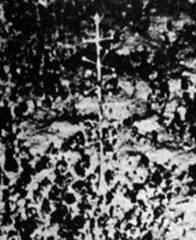
Between 1962 and 1979 the NSF Polar Research Vessel Eltanin surveyed Antarctic waters studying the ocean floor. In 1964 the ship photographed this unusual object at a depth of 13,500 feet. At the time there was no submarine capable of carrying such a piece of technology to this depth. The object appears to be a pole rising from the ocean floor with 12 spokes radiating from it, each ending in a sphere. The spokes are at a 15-degree angle to each other. The object is located 1,000 miles south of Cape Horn (southern tip of South America) beneath some of the most inhospitable seas in the world. Marine biologists have speculated that it might be some sort of organism, largely because it is otherwise so difficult to explain. However, there is no known form of marine life that looks remotely like this object. Several other theories exist but they are nothing more than forced explanations. (EOLAC:CC Pg. 368)
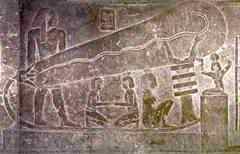
This intriguing glyph comes from the Hathor Temple in Dendera, Egypt. It went largely unnoticed throughout the archaeological community until a group of electrical engineers saw it. Their interpretation was that it closely resembled a light bulb/lamp with a cable leading to a power source. They observed that certain elements, especially the cables, are virtually an exact copy of engineering illustrations currently used. The cable is shown as very heavy, and striated, indicating a bundle of many conductors, rather than a single high voltage cable. (EOLAC:CC Pg. 361)























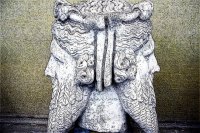






























 irida
irida bglavac
bglavac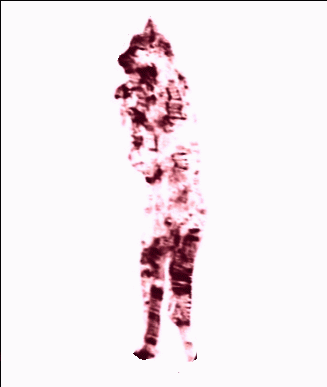 edin.kecanovic
edin.kecanovic



















































